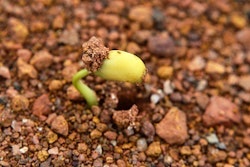Throughout the EU, conditions varied for compound feed producers in 2014, as Feed International‘s World Feed Panorama shows.
The European Feed Manufacturers’ Federation (FEFAC) has reported its analysis that the 28-country EU region produced 153.6 million metric tons of compound feeds in 2014 or about 0.6 percent less than in 2013. It described reductions of 1.5 percent for cattle feeds and 1 percent for pig feeds, although poultry feeds were up by 0.6 percent.
As a consequence, said FEFAC, poultry feed consolidated its position ahead of pig feed as the largest segment of EU-28 compound feed production.
While most member states saw total-tonnage decreases, Poland defied the trend by recording a 7 percent annual growth rate.
Highs and lows in France
To judge from an index calculated by French poultry institute Itavi, the raw material costs for chicken feeds in France have started 2015 at their lowest since January 2012. Of course, there have been big variations month by month over those three years, the volatility being characterised by the index rising 40 percent between January and October of 2012. Compared with January 2012, by January 2013 the index was up 32 percent, and at the start of 2014 it was higher by 8 percent. When compared with the average for 2013, the 2014 index rating on particular materials was lower by between 11 to 17 percent. In France, after rising by 4.3 percent from 2012 to 2013, the cost of production for chickens dropped by 7.5 percent in 2014. Broiler feed demand in France reflected this last year by falling by almost 5 percent from 2013. But, there was some compensation from a 1 percent rise in layer-hen feeds together with feed tonnage increases of 2 percent for turkeys and nearly 3 percent for ducks.
France was once the largest producer of compound feeds in Europe. That status slipped further away in 2014 when the lower poultry volume coincided with a reduction of about 4 percent in feeds for pigs and a feed slippage around 3 percent in the ruminants segment. Germany now leads the EU members on annual feed tonnage, followed by France and Spain.
Geopolitical issues make headlines
But there was a bigger story than feed costs for France’s poultry producers in 2014. From early in the year, Russia imposed a ban on importing poultry products from European Union countries. This was especially hard for France as Europe’s largest exporter of chicken meat. With French product returning to the domestic market and at the same time an increase in the volume of poultry meat that France imported from its European neighbors, the inevitable effect was a poorer market price for the local producer.
FEFAC acknowledged that the Russian ban from February 2014 had been the most important single factor impacting EU feed volumes. Other observers reporting from Russia pointed to the ban as an apparent stimulus to the national feed market. Official data showed higher Russian feed production every month in 2014 than at the equivalent time of 2013 or 2012, and last year ended with a new record for the highest-yet monthly output.
However, the downside was an economic slowdown and weak ruble within Russia that raised the local cost of imported feed ingredients. Locally, it was claimed that the rise in raw material costs made such a dent in feed manufacturing profitability that 10 to 15 percent of mills decided to stop producing feeds last year or in early 2015.













